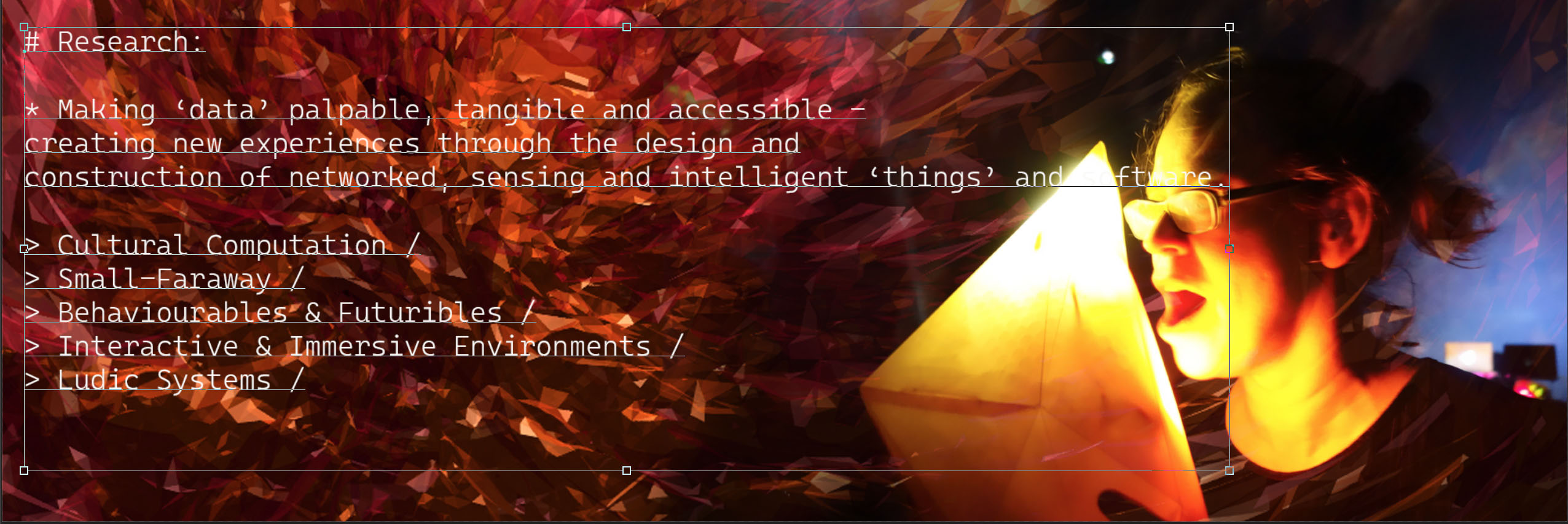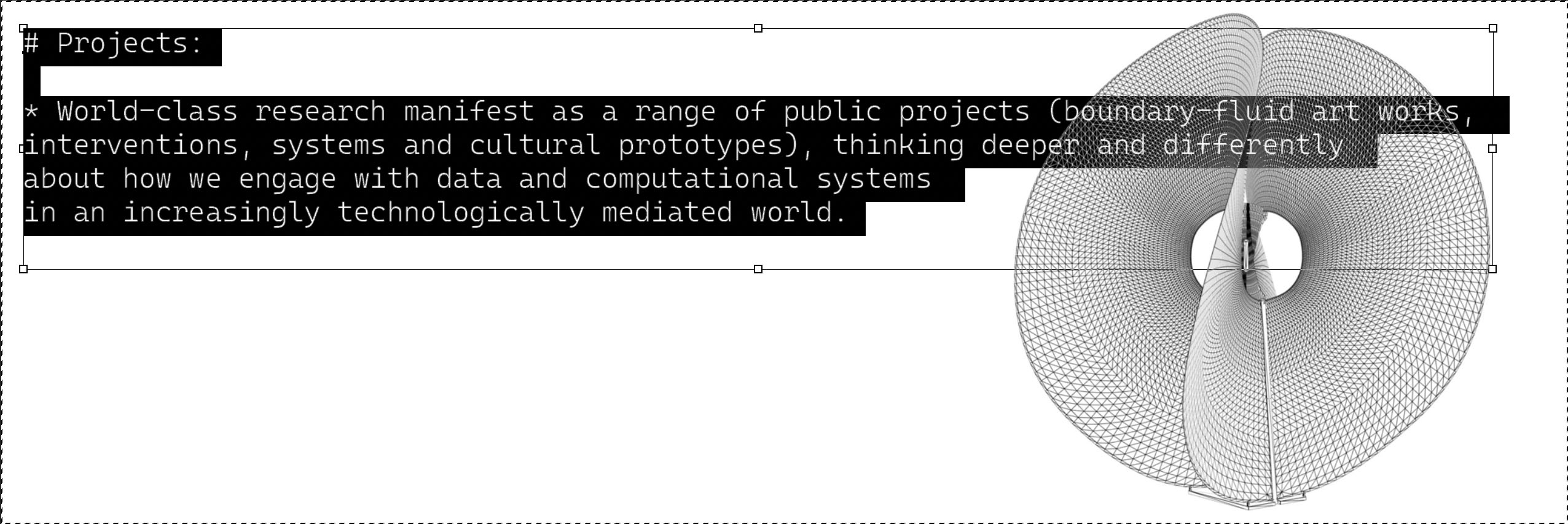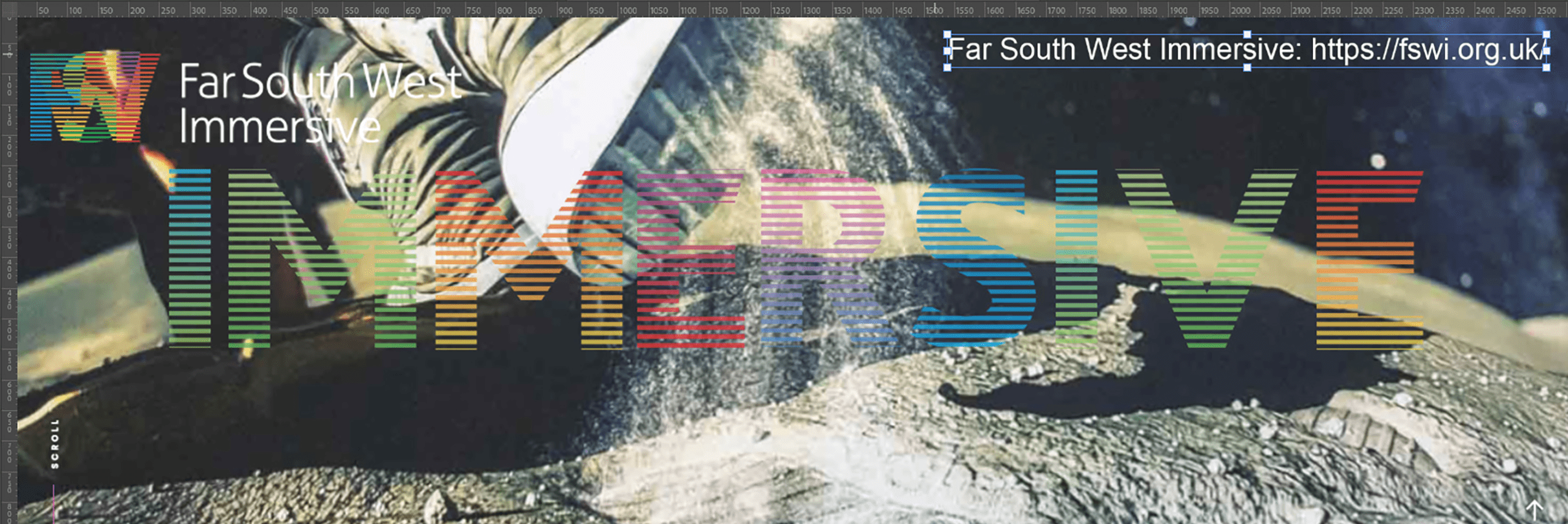Ctrl+Alt+Del: /ˈkrɒnɪk(ə)l/ Changelog:
Kronikel maps the stories that thread through i-DAT’s people, projects, research, learning and related activities. Kronikel links the rich mix of anecdotes, facts, and happenstance in order to track the chains of inspiration, influence and value that lurk within i-DAT’s history. It maps i-DAT’s temporal/spatial/creative/intellectual/ludic territory, ponders its past and algorithmically predicts its possible futures.
#1: A critical path {a fork of ‘The Story So Far’, Katie Tokus, 1990-2014} 2015-2021 under development and reformatted as a changelog…
Changelog: {under development}
2024:
* FDUK2023 @ CULTVR LAB...
* Donald Rodney: ‘Visceral Canker’. Spike Island.
- Context:
> Apple Vision Pro googly eyes...
> AI infests Mobile Phones...
> ...
2023:
* Far South West Immersive launched...
* Rickard Birkett's Donald Rodney Autoicon published...
* FDUK2023 @ CULTVR LAB...
* Rear Windows premiered at Belfast International Arts Festival...
* name = input("Celine Dearing: ")
- Context:
> "If you hadn't nailed it to the perch, it would be pushing up the daisies! It's rung down the curtain and joined the choir invisible. This is an X-Twitter!”
> Tech industries upgrade by downsizing, rightsizing, restructuring, and optimizing...
> An epic of epic epicness vs Google X Apple...
2022:
* i-DAT contributes to the Jena FullDome Festival Jury and Frameless Forum…
* Fulldome UK 2022 comes back home to Plymouth… again…
* Ludic-Architectures collaborative online Virtual Reality environment linking UK and China participants through the Fulldome/VR/Desktop… https://i-dat.org/ludic-architectures/ …
* Virtual Dartmoor: Laser Scanning a Devon Farmhouse with Time Team…
- Context:
> ChatGPT Pandemic.
> the billionaires came back.
2021:
* Devonport Market Hall Fulldome is launched.
* Dr. Helen Pritchard has been awarded a grant of £500,000 together with her collaborator Eric Snodgrass (Linkoping University) by the Swedish Energy Agency as Co-PI for “Regenerative Energy Communities” a 3 year project employing creative design methods in order to explore novel possibilities of energy provision.
* i-DAT secures £200k to revamp the Immersive Vision Theatre.
* Fulldome UK 2021 comes back home to Plymouth
* name = input("Rafael Arrivabene: ")
* name = input("Lauren Hayhurst: ")
- Context:
> Perseverance lands on Mars.
> mass exodus of billionaires from planet Earth.
> Remember the metaverse?
2020:
* Donald Rodney - Autoicon exhibited to much acclaim at Thirteen Ways Of Looking exhibition at the Herbert Art Gallery & Museum, Coventry.
* Psalms is acquired by the Tate.
* Vol 7 – Ubiquity Journal of Pervasive Media, the ultimate edition.
* Figurations of Timely Extraction. Pritchard, Rocha and Snelting build on a mixed methodology combining ethnography with practice-based experimentations with game engines and 4D earth modelling software to untangle the complex worldings that emerge parallel to, yet irreducible to, the logics of contemporary extractivist capitalism, and outline affirmative modes for understanding timely extraction differently through complexity and alliance. Vol 4 No 2 (2020): Mediating Presents | Media Theory.
* sys.exit(Iain Lobb)
* sys.exit(Adam Russell)
* name = input("Helen Pritchard: ")
* name = input("Joel Hodges: ")
* name = input("Musaab Garghouti: ")
- Context:
> Zoom does quite well.
2019:
* i-DAT leads a delegation to the ix SYMPOSIUM IMMERSION-EXPERIENCE at SOCIÉTÉ DES ARTS TECHNOLOGIQUES [SAT]
* i-DAT curates and assembles Future History, a look in the rear-view mirror as we accelerate through this post-digital phase of our cultural evolution. It celebrates the last 25 years of radical innovation in arts practice, education and research and locates Plymouth at the centre of it all.
* i-DAT installs an interactive Digital 3D Model of Bronze Spheric Theme was co-produced with i-DAT and Tate Digital for the Naum Gabo Exhibition at Tate St Ives.
* sys.exit(Stavros Didakis)
* name = input("Andy Prior: ")
* name = input("Chris Booth: ")
* name = input("James Sweeting: ")
- Context:
> Something was brewing.
2018:
* The Infinite Guide explores how people 'feel' about Artificial Intelligence (AI) powered conversational systems.
* i-DAT co-directs the South West Creative Technology Network (SWCTN) (1918-2021) a £6.5 million project to expand the use of creative technologies across the South West, through fellowships and prototypes around the themes of immersion, automation and data.
* i-DAT is a co-I with the IVT on the Environmental Futures & Big Data Impact Lab. University of Exeter, Exeter City Futures, the Met Office, the University of Plymouth, Plymouth College of Art, Plymouth Marine Laboratory, and Rothamsted Research. The Impact Lab is part-funded by the European Regional Development Fund. Total funding is £6.4 million.
* i-DAT launches CODEX, an international Postgraduate Research network operating in the volatile and dynamic space that frames new interdisciplinary art and design practices. In collaboration with Jiangnan university, Nanjing University of the Arts and Soochow University.
* sys.exit(B Aga)
* sys.exit(Michael Straeubig)
* sys.exit(Chris Hunt)
* name = input("Iain Lobb: ")
* name = input("Adam Russell: ")
- Context:
> Meltdown and Spectre bugs.
> Deepfakes are all the rage.
> Cambridge Analytica were a thing.
2017:
* i-DAT releases Emoti-OS, a speculative chatbot, (a computer program that mimics conversation with people using artificial intelligence), with a visual and emotionally driven character.
* i-DAT hosts the 6th edition of the BunB conference. A Sense of Place is produced by i-DAT in collaboration with the Sustainable Earth Institute and Art and Sound at Plymouth University, BunB17 is being produced in collaboration with the North Devon’s UNESCO Biosphere Reserve, Beaford Arts and Fulldome UK.
* sys.exit(Simon Lock)
* sys.exit(Paul Maguire)
* name = input("Mike Blow: ")
* name = input("Michael Straeubig: ")
- Context:
> Botnet of Things. Things go mad.
> Pay with your face.
2016:
* Playing with algorithms in the Tate Modern: i-DAT makes TIWWA - This Is Where We Are. Installation, Tate Modern, Switch House Launch.
* Fulldome UK 2016, born in i-DAT but again at the National Space Centre, Leicester.
* Liber Legis – (AIWASS v2.0.) exhibited at Cairotronica (Cairo International Electronic and New Media Arts Symposium), Ministry of Culture, Palace of Arts, Cairo, Egypt.
- Context:
> Pokémon Go happened.
> The first 1TB SD Card.
> Amazon delivery drones are a thing…
2015:
* Artory Plymouth wide audience metrics apps (Android & IoS) pilot programme kicks off.
* i-DAT codesigns Murmuration, Dream Collider, Liminal Spaces: EMDL Productions, SAT (Society for Arts and Technology), Montreal, Canada.
* i-DAT DataJams at the Turbine Festival: One City in the Tate Modern.
- Context:
> Apple Watch is born.
> Everyone is scared of AI.
2014:
* i-DAT hosts Young Rewired State’s Festival of Code, with a thousand of the nation’s young coders.
* i-DAT becomes the UK partner in an international collaboration awarded € 400k by the EU Culture Programme to innovate art form and push the boundary of immersive audio-visual full-dome environment as a platform for creative innovation.
* i-DAT’s Qualia technology underpins Artory – a culture app for Plymouth that rewards users for their feedback after shows, exhibitions and gigs.
- Context: > "the Internet of Things" is a thing!
> Google release Android Wear watch created by MA Digital Futures graduate Emmet Connolly https://i-dat.org/emmetconnolly/
2013:
* i-DAT develops Qualia: an arts audience feedback and evaluation tool that can measure mood and sentiment.
* The city of Plymouth is turned into a massive, multiplayer game during the transmedia event Resurgam: The Lost Pearl of Plymouth.
* name = input("Chris Hunt: ")
- Context:
> Google Glass is introduced.
2012:
* Herman Melville’s classic of literature Moby Dick is read out by the famous and the not so famous, digitised and placed online by i-DAT. More than 3million people enjoy the Moby Dick Big Read.
* i-DAT is given National Portfolio Status by Arts Council England.
* name = input("Dawn Melville: ")
* name = input("Mike Blow: ")
* sys.exit(Joasai Krysa)
* sys.exit(Hugo De Rijke)
- Context:
> Oculus Rift is introduced.
> The number of smart phones worldwide reaches 1 billion.
> The Raspberry Pi is born.
2011:
* i-DAT works with wearable technologies that collect data from the body and from human activity in a bid to ‘extend human perception’.
* IBM Smarter Planet Lab is unveiled in Babbage 213.
* sys.exit(Pete Carss)
- Context:
> IBM's Watson supercomputer beats TV Quiz show humans.
2010:
* i-DAT collaborates with nanotechnologists and makes nano-art using an Atomic Force Microscope.
* Sensors are placed in and around Devon’s River Torridge by i-DAT to generate ecological dart to use in a schoolchildren’s art project.
* sys.exit(Geoff Cox)
* sys.exit(Musaab Garghouti)
* sys.exit(Katina Hazelden)
* name = input("Simon Lock: ")
- Context:
> The iPad is born.
2009:
* i-DAT leaves the School of Computing and relocates to the School of Art & Media, Faculty of Arts & Humanities.
* The i-500 Public Art Commission is for Curtin University’s to be incorporated into the fabric of a building to encourage building users to communicate and collaborate.
* sys.exit(Dan Livingstone)
- Context:
> First Bitcoins mined.
> Minecraft is born.
2008:
* i-DAT hosts the EUROPEAN WORKSHOP IN IMMERSIVE CINEMA which births the FULLDOME UK Festival, the annual event for fulldome art.
* sys.exit(Chris Speed)
- Context:
> Google and T-Mobile unveiled the G1 with Android OS.
2007:
* i-DAT turns a building into a giant video screen, linking mobile phones with sound and light commands.
* i-DAT exhibits experimental sound work from over 100 artists in collaboration with Sonic Arts Network in Plymouth
* name = input("Gianni Corino: ")
* sys.exit(Ade Ward)
- Context:
> The iPhone is released.
2006:
* i-DAT installs an interactive entity into its host building that can answer questions that are texted to it from mobile phones.
- Context:
> Twitter is born
2005:
* i-DAT unveils Arch-OS, its operating system for buildings and intelligent architecture. Arch-OS is installed into i-DAT’s new home at Portland Square, including a ‘random floor’ button in two of the building’s lifts.
* name = input("B Aga: ")
* name = input("Pete Carss: ")
* name = input("Katina Hazelden: ")
- Context:
> The first video is uploaded to YouTube.
> Google Maps launches – 5 years after i-DAT’s satellite maps project STI.
2004:
* Out of Scale: Out of Scale explores architecture’s relationship with image, digital technology, structure and materials, by focusing upon microscopic detail.
* i-DAT commissions artists Peter Fend to use satellite data to demonstrate how research can generate productive dialogue about global ecological problems and be used to develop effective solutions.
* name = input("Musaab Garghouti: ")
* sys.exit(Limbomedia <George Grinstead / Adam Child / Scott Fletcher / Dan Harris / Andrew Melmouth>)
- Context: > Facebook launches.
2003:
* i-DAT puts an iMac in a monkey enclosure and waits to see what the animals write. The story is flashed around the world, giving i-DAT global exposure and intense media coverage.
* CAiiA-STAR becomes the Planetary Collegium.
* sys.exit(Nema Hart)
* name = input("Ade Ward: ")
- Context:
> Apple’s iTunes store is introduced, selling downloads for 99c.
> Skype is released.
2001-2002:
* V01D Exhibition,
* Catalogue Plymouth Arts Centre. Part of Architecture Week.
* name = input("Hugo De Rijke: ")
* name = input("Nema Hart: ")
- Context:
> Wikipedia launches.
> Apple unveils the first generation iPod portable media player.
> Minority Report, directed by Spielberg and based on a Philip K Dick story.
2000:
* MSc Digital Futures is launched in the School of Computing, Faculty of Technology as an online and symposium/low residency programme.
* i-DAT co-ordinates the Search for Terrestrial Intelligence anticipating Google Maps.
* Donald Rodney Autoicon.
* name = input("Limbomedia <George Grinstead / Adam Child / Scott Fletcher / Dan Harris / Andrew Melmouth>: ")
* name = input("Joasia Krysa: ")
- Context:
> The Y2K bug didn’t come!
1999:
* i-DAT develops the online Panopticon VRML/Web system to support the emergence of MSc Digital Futures.
* name = input("Geoff Cox: ")
* sys.exit(Mic Cady)
- Context:
> Wi-Fi is born in two variants - 802.11a / 5.8GHz band & 802.11b / 2.4GHz band.
> The Y2K bug is coming!
1998:
* Macromedia officially launch he Multimedia Studio, 213 Babbage Building.
* i-DAT is born.
* Artefact is one of its early projects, encouraging visitors to manipulate and remix pieces in a virtual gallery in this collaboration with the Victoria & Albert Museum.
* The INTERSTICES Symposium, ‘The Architecture of Consciousness’ was originally held on August 23 – August 25, 1998 at Port Eliot House, St Germans, Cornwall.
- Context:
> The iMac is introduced, with colour-coded computers as domestic furnishings.
> Tiger Electronics launch the Furby electronic toy, the first domestic robot.
> The Data Protection Act 1998.
1997:
* Psalms is the Autonomous Wheelchair constructed by Guido Bugmann for Donald Rodney’s “Nine Night in Eldorado” at the South London Gallery.
* Roy Ascott formulates CAiiA-STAR as a constituted trans-institutional research platform.
- Context:
> IBM's Deep Blue supercomputer defeats Garry Kasparov.
> What did we do before the Compact Disc-ReWritable (CD-RW)?
1996:
* The PhD programme STAR is established alongside MLA, with Roy Ascott appointed as visiting professor.
* name = input("Jan Bennett: ") Discussions begin to establish a ‘digital’ Centre of Expertise through the Higher Education Innovation Fund (HEIF).
* sys.exit(Paul Maguire)
* name = input("Chris Speed: ")
* name = input("Mic Cady: ")
- Context:
> Tomb Raider is unveiled
> The first Tamagotchi digital pet is released in Japan.
1994-95:
* The first satellite broadcast of Mediaspace mixed-media TV programmes – including a networked comic - takes place from BSc MediaLab Arts at Plymouth University Hoe TV Centre – anticipating the arrival (10 years later) of transmedia publishing.
* name = input("Paul Maguire: ")
* name = input("Dan Livingstone: ")
- Context:
> Iomega Zip Disk is released.
> World Wide Web Consortium (W3C) is formed.
> Java and PHP programming languages arrive.
1993:
* name = input("Roy Ascott: ") becomes the first external examiner for MediaLab Arts.
* name = input("Brian Eno: ") is made Honorary Doctor of Technology for his services to MediaLab Arts (and the universe).
* Mike Phillips starts experimenting with the Hoe TV Studio and the ESA Satellite UpLink to establish the Mediaspace series of interactive satellite broadcasts.
- Context:
> The first Pentium chips are shipped, improving the performance of personal computers.
> Wired Magazine launches.
> Doom is released.
1992:
* name = input("Mike Phillips: ") 30/06/1992, is interviewed on his 30th birthday for the post of programme manager for MediaLab Arts. He gets the job to establish the course within the School of Computing at the newly-renamed University of Plymouth and spends August recruiting in time for the first ever intake of 35 students in September.
* name = input("Brian Eno: ") becomes a Virtual Adviser to MediaLab Arts.
* Tony Tucker of Macromedia provides sponsorship for MediaLab Arts with Magic, Director and Authorware.
* A new suite of Apple Mac LC II and Quadra 800 machines is installed in Babbage 108. The labs later move to the 2nd Floor rooms 212 and 213.
- Context:
> Windows 3.1 is announced.
> John Cage dies.
1990 - 1991:
* BSc MediaLab Arts, the kernel that became i-DAT, evolved from a collaboration between Lesley Kerman (Head of Department of Humanities, Performance, and Media at the Faculty of Art & Design, Exeter (formerly Exeter College of Art & Design (ECAD)) and Dr Pat Pearce (Head of the School of Computing, Faculty of Technology, Plymouth).
* ECAD was swallowed by Polytechnic South West (PSW) in 1989 and after a merger with Humanities subjects in Rolle College Exmouth, evolved into the current Faculty of Arts, Humanities, and Business in the transition to the University of Plymouth (1992) and its relocation to the Roland Levinsky Building (2007).
* Mike Phillips, was teaching hypermedia, networking and desk-top publishing in 4D/ BA Fine Art, BA Media and MA Publishing, volunteered to work with staff in the School of Computing to develop what became the BSc MediaLab Arts Programme.
- Context:
> Donald Rodney (1961–1998) commissioned by TSWA Four Cities Project to build Visceral Canker (1990) installed on Mount Edgcumbe old gun emplacement between Barn Pool and the Cremyll Ferry landing (acquired by the Tate 2009). Mike Phillips helps build the work which consist of two heraldic shields (John Hawkins and Elizabeth I) peristaltic pumps, control boards and power units sandwiched between Perspex sheets. The original plan to pump Donald’s blood was vetoed by Plymouth City Council and red autopsy dye was used.
> Thom Yorke (later lead singer of Radiohead) works on Mike Phillips’ Mac Plus developing interactive Hypercard Stacks at Exeter College of Art & Design. The band rehearse in the video editing suite.
> Tim Berners-Lee publishes formal proposal for the World Wide Web and the first known web page is written.
> Microsoft announces its latest version of its operating system: Windows 3.0





